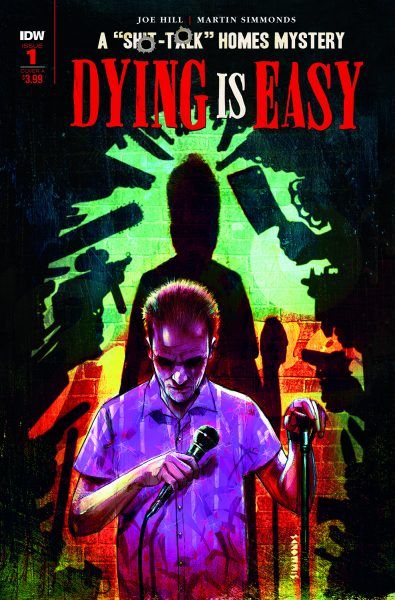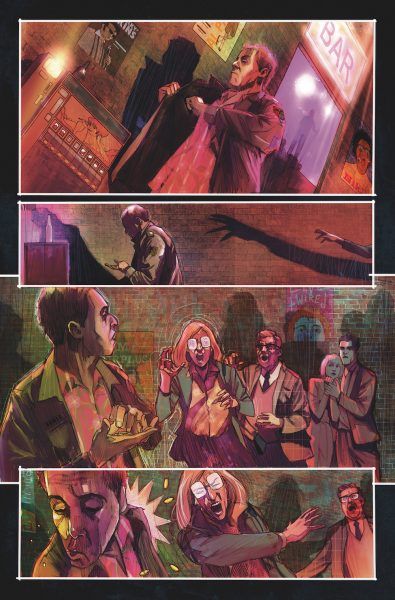Joe Hill has a murder mystery for you to solve in his new IDW comic, Dying Is Easy. The first issue in the five-part miniseries arrives this Wednesday, December 11th with a story that follows Syd “Shit-Talk” Homes, a disgraced ex-cop, bitter stand-up comic and wanted felon. And it's our pleasure to not only give you an exclusive look at an atmospheric page from the comic's first issue--with illustrations provided by the visually dynamic Martin Simmonds--but insight from Hill himself!
We had a chance to chat with Hill about the inception of Dying Is Easy and Shit-Talk Homes, how difficult it was to craft a mystery that readers could solve (but not too quickly), and the possible future for his stand-up sleuth. Plus, with the long-awaited adaptation of Hill's IDW work Locke & Key finally arriving on Netflix in early 2020, we got his thoughts on that as well.
Keep an eye out for my review of issue #1 here on Collider, but if you want to get your hands on your own copy, be sure to check out IDW Publishing and support your local comic shops using www.comicshoplocator.com to find your copy
Here's what Hill had to say about Dying Is Easy, along with the comic's first cover and our exclusive look at a pivotal page from the story, plus a tease for his upcoming new Netflix series Locke & Key:
With the success of Joker, it feels like a good time to release 'Dying Is Easy.' I'm assuming that's happy coincidence, but how long has the idea for Syd "Shit-Talk" Homes been kicking around in your mind?
Joe Hill: Wellllll, Syd is a different kind of clown, and probably would take a pass on the white greasepaint and the green hair. Ultimately, though, I guess there's something archetypal about the jester as a chaos agent, a figure who reveals important truths by shaking things up.
Mysteries and jokes have a lot in common. In a good mystery, the solution is a bit like the punch line to a clever gag: a jolting but somehow perfectly satisfying revelation.
I don't know when I came up with the idea for Syd. But I've always been curious about different kinds of writing and at some point a few years ago I began wondering what it would be like to write for a comedy show, like Seth Meyers or Jon Oliver. It's possible Syd started there: with the dawning realization that comedians are basically writers who deliver their stories orally.
Much of the first issue focuses on either Syd's stand-up set or him bullshitting with his pals. Was that challenging for you to write from a comedy perspective, even if it's darkly humorous?
Hill: The scene setting was easier than structuring the mystery. For years and years I was a basically instinctual writer -- I wouldn't know where a story was going, I'd just trust narrative momentum to get me there. I still refuse to outline. Outlines rub my fur the wrong way.
But in the last few years, I've found it important to fully understand my character's backstories before I really get going. Or, to put it another way, I don't think it's a good idea to write a murder mystery, unless you know who the killer is, and have some clever ideas about how to plant the clues.
Charles Finch, the novelist and critic, described an approach similar to my own in a recent and really remarkable piece for [Vulture].
What was it about Martin Simmonds visual style that made him the perfect artist to bring the story of 'Dying Is Easy' to life?
Hill: Expressive body language is important for a mystery... sometimes what a character is saying is at odds with what his body is saying, and that contradictory information can be valuable to the reader. Martin's characters all express themselves physically in very distinctive ways. Also, he's his own colorist, and his palette brings in a whole noir sensibility: blurred neon lights reflecting off the blacktop in rainy alleys, the ghost-like film of cigarette smoke in a dimly lit club. Visually, Dying is Easy comes across like a Sidney Lumet film or cheap, low-budget, early Scorsese. Which was what we were going for from the start.
In a recent interview, you said of 'Dying Is Easy':
“Both as a writer and reader, nothing turns me on like that jolt of discovery and revelation, when the scattered parts of a narrative suddenly click together to make an unexpected picture. That’s the thrill of a fair-play mystery, where all the clues are there if the reader is clever enough to spot them, and there’s a chance to match wits with the detective.”
How difficult was it to meter out the clues over the five issues so that super-sleuths didn't solve the cliffhanger ending in Issue #1 but so you had enough breadcrumbs for readers to keep pace with Homes?
Hill: Ahhhh, pretty hard and only time will tell if I did it well! I watched Foyle's War religiously, and read Anthony Horowitz's novels like a student taking notes in a class he wants to ace. Hopefully I picked up a few things about proper clue placement and misdirection.
Would you like to see Homes' story continue, either in future comics or in an adaptation of some sort?
Hill: I imagined Dying is Easy as the first story in a whole series of Syd Homes adventures. I'd love another writer to tackle the second story, and then a third writer to hit the one after that, and then I'd circle back and write the fourth. Like a TV show with a stable of writers to produce new episodes. But I also think we need to see how this first one lands. If people are digging Syd, there'll definitely be more. Martin Simmonds is up for it!
What's up next for you? (And congrats on *finally* being able to see Locke & Key on Netflix next year!)
Hill: Oh, yeah, I can't wait for Locke & Key to hit. I've seen all ten episodes and this thing is like TV crack. It's one of the most Netflix-y Netflix shows I've ever seen and I mean that in the best possible way... it was chemically engineered to be binged.
Beyond that, I'm writing some horror mags for IDW's Distinguished Competition, where I've got my own imprint, Hill House Comics. I've wrapped up the scripts on Basketful of Heads, my story of sex, lies, and decapitation, and am midway through Plunge, the Arctic shocker I'm working on with Stuart Immonen. I'm doing everything I can to encourage colorists throughout the business to discover and use new shades of red.
Look for Dying Is Easy this Wednesday, December 11th



